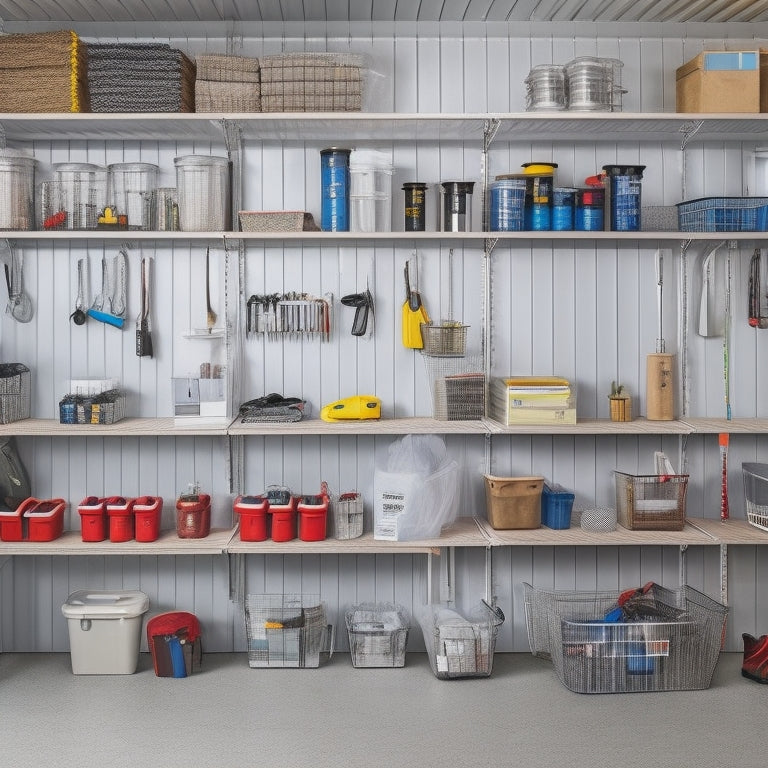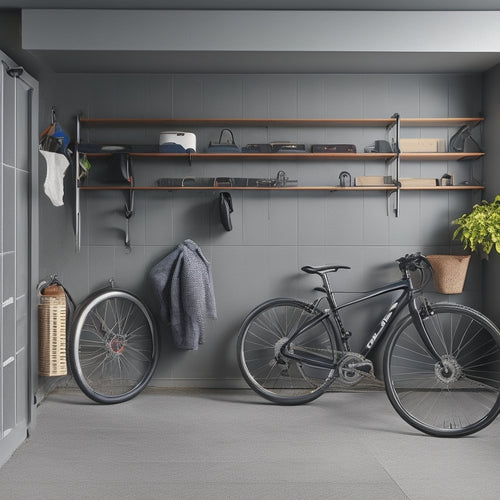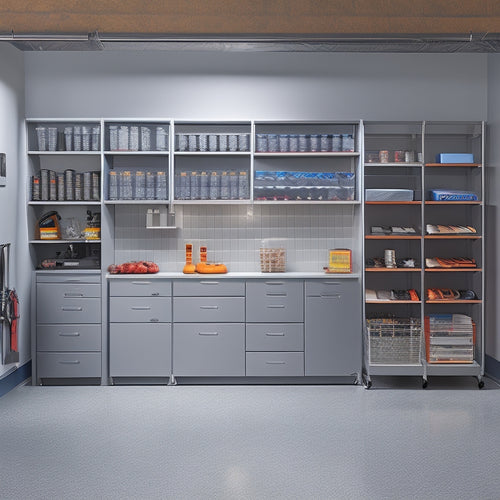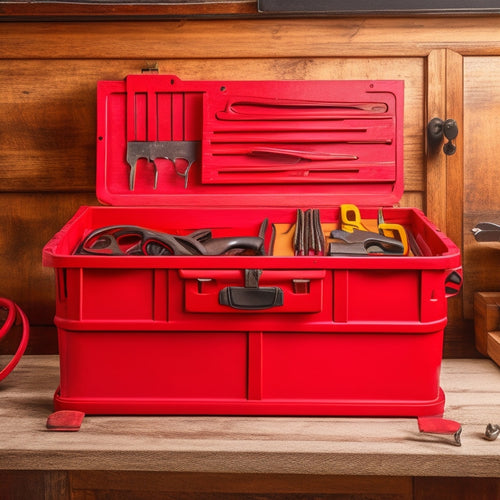
Bin Organization Hacks to Maximize Storage
Share
You're likely wasting around 30% of your storage space due to poor bin organization, but with the right strategies, you can optimize your storage capacity and keep your belongings tidy. Start by grouping similar items together, using clear labels, and categorizing by function or color. Position frequently used bins in easy-to-reach locations and consider vertical storage solutions to maximize space. Customizing bin sizes and shapes can also help, especially for awkward areas. By implementing these hacks, you'll be able to breathe a sigh of relief as your clutter disappears - and there's even more to uncover when you take the next step towards a more organized you.
Key Takeaways
- Use a color-coding system to visually categorize bins and enhance organization, making it easier to find what you need.
- Implement a "one-touch rule" to handle each item immediately, storing it in its designated bin to foster instant organization.
- Optimize storage capacity by utilizing vertical space with shelf brackets, wall-mounted bins, and overhead storage solutions.
- Create a bin inventory system with digital records, regular audits, and user-friendly software to maintain accurate inventory tracking.
- Assign specific homes for items, using task-based labels, clear visibility, and size-appropriate bins to ensure easy access and minimize clutter.
Labeling and Categorizing Bins
As you stand in front of your newly acquired bins, you're probably wondering where to start with organizing them.
Begin by grouping similar items together using function-based grouping, such as storing all cleaning supplies in one bin and all craft materials in another. This makes it easy to find what you need when you need it.
Use size differentiation to separate larger items from smaller ones, keeping the most frequently used items in the most accessible bins.
Consider a color-coding system, where each bin theme corresponds to a specific category, such as red for kitchen items and blue for bedroom items.
Material selection is also essential; choose durable bins that can withstand the weight and frequency of use.
Label each bin using clear, concise labels that indicate what's inside, and consider adding visual cues like icons or images for quick identification.
For seasonal organization, label bins with the specific season or holiday they're intended for, making it easy to swap out items as needed.
Bin Placement and Accessibility
Within your newly organized space, strategically placing your bins is vital for maintaining efficiency and ease of use. This guarantees that you can quickly find what you need when you need it, reducing frustration and saving time.
When deciding on bin placement, consider the following factors:
-
Frequency of use: Place bins containing frequently used items in easy-to-reach locations, guaranteeing quick bin access.
-
Bin dimensions: Position larger bins on lower shelves or near the floor, while smaller bins can be placed on higher shelves or in harder-to-reach areas.
-
Bin layout: Organize bins in a logical layout, grouping similar items together to simplify routing and improve bin accessibility.
Stacking and Nesting Bins
You've optimized bin placement for easy access and efficiency. Now, it's necessary to maximize storage by stacking and nesting bins. This technique allows you to store more items in a smaller space, keeping your area organized and clutter-free.
When stacking bins, it's crucial to use bin stacking techniques that prioritize stability and safety. Start with larger bins at the bottom and gradually add smaller ones on top, ensuring each bin is aligned and secure. This prevents bins from toppling over and reduces the risk of injury.
Nested bin benefits include:
| Bin Size | Stacking/Nesting | Benefits |
|---|---|---|
| Large | Stack | Maximizes storage space |
| Medium | Nest | Reduces clutter, easy access |
| Small | Stack | Saves floor space, organized |
| Extra-Large | Stack | Stores bulky items securely |
| Various | Nest | Customizable storage solutions |
Utilizing Vertical Storage Space
The most efficient storage systems make the most of vertical space, and your bin organization system is no exception. By utilizing vertical storage space, you can maximize your storage capacity while keeping your floors and surfaces clear. This is especially important in areas with limited space, such as garages, closets, or small rooms.
To make the most of your vertical space, consider the following:
- Install shelf brackets to create additional storage areas for your bins.
- Use wall mounted bins to store items that you don't need frequent access to, such as seasonal decorations or out-of-season clothing.
- Opt for overhead storage solutions, like ladder racks or hanging organizers, to store items that are less frequently used.
Additionally, consider pegboard solutions, vertical shelving, and magnetic strips to further increase your storage capacity.
Stackable crates and corner shelving can also be used to make the most of tight spaces. By utilizing these vertical storage solutions, you'll be able to store more items in a smaller area, keeping your space organized and clutter-free.
Customizing Bin Sizes and Shapes
Your bin collection is unique, and so are the items you're storing. That's why customizing bin sizes and shapes is vital to maximize your storage space. With custom bin designs, you can create bins that fit perfectly around corners, under shelves, or in tight spaces.
Adjustable bin sizes allow you to adapt to changing storage needs, while creative bin shapes help you employ awkward areas. Modular bin systems offer flexibility and versatility, letting you mix and match bins to create a personalized storage solution.
Multifunctional bin uses, such as bins with built-in handles or wheels, make it easier to move items around. Aesthetic bin options like decorative labels or colorful bins add a touch of style to your storage area.
When selecting bins, prioritize durable bin materials that can withstand heavy use and harsh environments. By choosing the right bin for the job, you'll guarantee your items are safe and secure.
With customized bin sizes and shapes, you'll be able to store more efficiently, reduce clutter, and create a safer, more organized space.
Creating a Bin Inventory System
Creating a Bin Inventory System
Cataloging your stored items is essential to maintaining a well-organized space. You'll be able to quickly locate what you need and identify what's running low. A bin inventory system helps you keep track of your stored items, ensuring you're always prepared and reducing the risk of overstocking or running out of essential supplies.
To create an effective inventory system, consider the following:
-
Digital records: Keep digital records of your stored items, including quantities and expiration dates. This makes it easy to update your inventory and access the information from any device.
-
Inventory tracking: Use a system to track when items are added or removed from storage. This helps you identify patterns and anticipate future needs.
-
Regular audits: Schedule regular audits to verify the accuracy of your inventory records and identify areas for improvement.
Assigning Bins to Specific Tasks
You're taking your bin organization to the next level by assigning bins to specific tasks.
To make this system work, you'll need to create labels that clearly indicate the task or category each bin belongs to - after all, bin labels matter.
Bin Labels Matter
Bin Labels Matter
A well-organized bin system relies on clear labels to guarantee everything has its designated place. Labels help you quickly identify what's inside each bin, making it easier to find what you need and preventing clutter from building up.
When it comes to labeling your bins, you want to make sure they're durable and easy to read.
To take your bin labels to the next level, consider the following:
-
Color coding: Use different colored labels or stickers to categorize your bins by type, such as blue for cleaning supplies or red for hazardous materials. This visual system helps you quickly identify the contents of each bin.
-
Label durability: Choose labels that can withstand the environment they'll be in. For example, if your bins will be stored in a humid garage, look for labels that are water-resistant.
-
Clear descriptions: Use simple, descriptive language on your labels so you can easily identify what's inside each bin. Avoid using abbreviations or acronyms that might confuse you or others.
Task-Based Bin Categories
Now that you've got your labels in order, it's time to think about how you can use your bins to streamline specific tasks and activities. Assigning bins to specific tasks helps you stay organized and focused on what needs to be done.
By categorizing your bins according to tasks, you can quickly identify what you need to accomplish and prioritize your workload using task prioritization techniques.
For instance, you can designate bins for seasonal tasks, such as winter clothing storage or summer gardening tools. This way, you can easily access the items you need when you need them.
You can also create bins for ongoing tasks, like a "to-donate" bin for items you want to give away or a "to-recycle" bin for paper and plastic waste.
Managing Clutter With Bin Dividers
A cluttered storage bin is like a messy closet - it's overwhelming and makes it difficult to find what you need. To regain control over your storage space, consider using bin dividers to separate and categorize your items.
Not only will this make it easier to locate what you're looking for, but it'll also improve the overall bin aesthetics.
When choosing divider materials, you have several options:
-
Cardboard inserts: Inexpensive and easy to customize, these dividers are perfect for small bins and lightweight items.
-
Plastic dividers: Sturdy and durable, these are ideal for larger bins and heavier items.
-
Fabric dividers: A great option for soft or delicate items, these dividers add a touch of elegance to your storage space.
Implementing a One-Touch Rule
When you're organizing your bins, you'll want to implement a one-touch rule to maximize efficiency.
This means you'll handle each item immediately, making a decision about what to do with it right then and there.
Handle It Immediately
By incorporating the one-touch rule into your bin organization strategy, you'll save time and energy in the long run. This rule is simple: when you pick up an item, deal with it immediately. Take immediate action and make a decision about what to do with it.
-
Put items away in their designated bins as soon as you're done using them, ensuring instant organization and swift storage.
-
Make fast decisions about what to keep, donate, or discard, allowing for prompt decluttering and rapid retrieval.
-
Use quick sorting to categorize items into their respective bins, enabling timely placement and easy access.
Designate a Home
You've got a handle on the one-touch rule, now it's time to assign a permanent address to each item. This is where the concept of "home" comes in.
Designating a home for your belongings means assigning a specific place where they'll be stored and easily accessible. This is essential for maintaining organization and preventing clutter from building up again.
Start by categorizing your home essentials into designated zones. For example, all cleaning supplies can go in one zone, while kitchen utensils go in another.
Within each zone, assign a specific bin or container to each item. This way, when you need something, you'll know exactly where to find it.
Maintaining Bin Organization Over Time
As your bin organization system becomes a habit, it's essential to schedule regular maintenance to prevent clutter from building up again. You've worked hard to get your bins organized, and with a little effort, you can keep them that way.
To maintain your bin organization, you'll need to set aside time for routine maintenance. This can be as simple as dedicating 10-15 minutes a week to tidying up your bins and verifying everything is still organized and easily accessible.
Here are a few tasks to focus on during your routine maintenance:
- Go through each bin and remove anything that's broken, expired, or no longer useful.
- Wipe down bins with a damp cloth to remove dirt and dust.
- Confirm labels are still readable and update them as needed.
In addition to routine maintenance, consider conducting a seasonal review of your bins. This is a great opportunity to reassess what you're storing, what you need, and what can be donated or thrown away.
Frequently Asked Questions
Can I Use Bins With Missing or Broken Lids?
You can definitely repurpose bins with missing or broken lids, but prioritize safety first. Consider bin repair or investigate lid alternatives like fabric, mesh, or DIY solutions to guarantee contents remain secure and accessible while maintaining a safe storage environment.
How Often Should I Clean and Disinfect My Bins?
You should clean and disinfect your bins regularly, ideally every 1-2 months, depending on usage and contents. Use a gentle cleaning product and disinfectant, and let them air dry to prevent moisture buildup and bacterial growth.
Are Fabric Bins as Durable as Plastic Bins?
Fast-forward to the Middle Ages, where knights protected their gear with fabric - a demonstration of its durability! You'll find fabric bins holding their own against plastic ones, with similar lifespans, but fabric's breathability wins for moisture-prone items.
Can I Use Bins in Humid or Damp Environments?
When storing items in humid or damp environments, you can use bins made from humidity resistant materials, and consider adding moisture absorbing inserts to keep contents dry and safe from water damage or mold growth.
Are Bin Organizers Suitable for People With Mobility Issues?
When dealing with mobility issues, you'll find that bin organizers can be a great solution, offering accessible storage and mobility solutions that cater to your needs, ensuring you can easily access what you need without straining yourself.
Conclusion
With your newly organized bins, your space is changed into a well-oiled machine, humming with efficiency. Clutter is banished, and serenity reigns. As you glide through your daily routine, you'll feel the weight of chaos lifting, like a bird taking flight. By implementing these bin organization hacks, you've tamed the beast of disarray, and in its place, you've created a haven of productivity and calm. Now, maintain your system, and bask in the joy of a clutter-free life.
Related Posts
-

Large Wall Hooks to Maximize Garage Space
You can effectively double your garage's storage capacity by installing large wall hooks that keep items off the floo...
-

Building a Garage Storage System With Built-Ins
You're about to build a garage storage system with built-ins that fits your unique needs, starting by evaluating your...
-

Portable Tool Chest Essentials
When stocking your portable tool chest, you'll want to prioritize essential hand tools like hammers, tape measures, a...


